Disponible avec la licence Location Referencing.
The measure is located at an offset distance from the From measure location. The reference offset data is translated to routes and measures for storage. As shown in the example below, the From measure of the event is first located, and the To measure is then located at an offset distance of 8 miles from the From measure location.
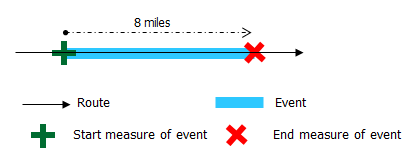
- Ouvrez Event Editor et, à l’invite, connectez-vous à votre organisation ArcGIS.
- Cliquez sur l’onglet Mise à jour.
- Dans le groupe Mettre à jour les événements, cliquez sur Événements ponctuels
 .
.Le widget Ajouter des événements linéaires apparaît.
Remarque :
Les sélections relatives au réseau ainsi qu’aux méthodes et aux mesures de départ et d’arrivée peuvent être prédéfinies lors de la configuration, de la création ou de la mise à jour des paramètres par défaut des jeux d’attributs.
En savoir plus sur la configuration, la création et la mise à jour des paramètres par défaut des jeux d’attributs.
- Cliquez sur la flèche de la liste déroulante Réseau et sélectionnez le réseau utilisé comme méthode de référencement linéaire (LRM) source pour la définition des mesures en entrée de nouveaux événements linéaires.
Le réseau est un réseau LRS publié en tant que couche dans Event Editor. Vous pouvez spécifier le réseau LRS à utiliser comme LRM afin de définir les mesures de départ et d’arrivée du nouvel événement linéaire. Event Editor accepte également les mesures dans un réseau ou une LRM autre que celui/celle avec lequel/laquelle la couche d’événements linéaires est associée.
Le nouvel événement sera associé aux itinéraires (aux ID d’itinéraire) du réseau LRS que la localisation de l’événement intersecte.
- Spécifiez le nom de l’entité linéaire sur laquelle se trouveront les événements de l’une des manières suivantes :
- Cliquez sur la flèche de liste déroulante pour sélectionner le nom de la ligne dans la zone de texte Nom de la ligne.
- Cliquez sur l’outil Sélectionner une ligne sur la carte
 et sélectionnez la ligne sur la carte.
et sélectionnez la ligne sur la carte.
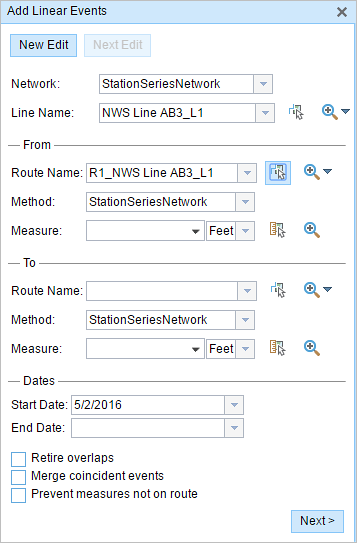
Conseil :
Si la ligne sélectionnée ne se trouve pas dans la vue active de la carte, cliquez sur Effectuer un zoom sur l’étendue de la ligne ou centrer sur le point de départ ou d’arrivée de la ligne sur la carte
 pour actualiser l’affichage de la carte et effectuer un zoom avant de manière à voir l’étendue totale de la ligne sélectionnée.
pour actualiser l’affichage de la carte et effectuer un zoom avant de manière à voir l’étendue totale de la ligne sélectionnée.La ligne est mise en surbrillance en bleu clair. La flèche à la fin indique le sens de calibrage de la ligne.
- Use any of the Location methods to locate the From measure of the event.
A green plus sign is placed at the offset location along the route on the map. This is the location of the From measure value for the events.
- In the To section, click the Method drop-down arrow and choose Length.
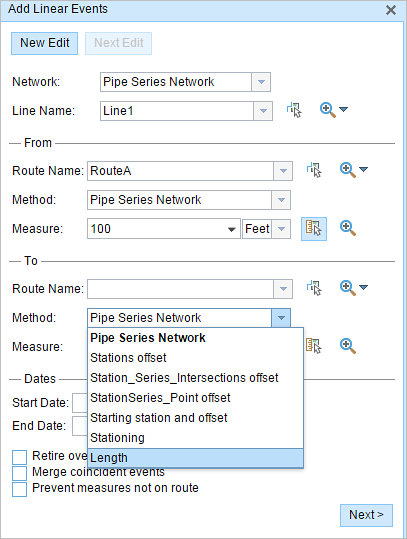
- In the To section, provide the offset value in the Length parameter and choose the units.
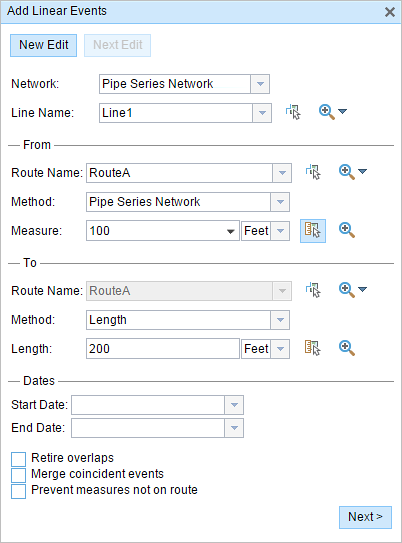
- Click the Select an Offset Location on the Map tool
 and choose a location along the route on the map.
and choose a location along the route on the map.
The Length denotes the distance between the From Measure location and the proposed To Measure on the selected route.
A red cross appears at the selected location on the map.
- Click the Select an Offset Location on the Map tool
- Choisissez la date qui définira la date de début des événements en procédant comme suit :
- Spécifiez la date de début dans la zone de texte Start Date (Date de début).
- Cliquez sur la flèche de liste déroulante Date de début et choisissez la date de début.
Par défaut, la date de début est la date du jour, mais vous pouvez sélectionner une autre date à l’aide du sélecteur de date.
- Choisissez la date qui définira la date de fin des événements en procédant comme suit :
- Spécifiez la date de fin dans la zone de texte End Date (Date de fin).
- Cliquez sur la flèche de la liste déroulante End Date (Date de fin) et choisissez la date de fin.
La date de fin est facultative. Si elle n’est pas renseignée, l’événement est toujours valable au moment présent et le restera à l’avenir.
- Choisissez une des options de validation des données pour éviter une saisie erronée lors de la caractérisation d’un itinéraire avec des événements linéaires :
- Supprimer les superpositions : le système ajuste la mesure et les dates de début et de fin des événements existants de sorte que le nouvel événement n’entraîne pas de superposition des valeurs temporelles ou des mesures.

- Fusionner les événements coïncidents : si toutes les valeurs attributaires d’un nouvel événement sont strictement identiques à celles d’un événement existant, et si le nouvel événement est adjacent ou se superpose à l’événement existant en matière de valeurs de mesure, le nouvel événement fusionne avec l’événement existant et la plage de mesure est agrandie en conséquence.
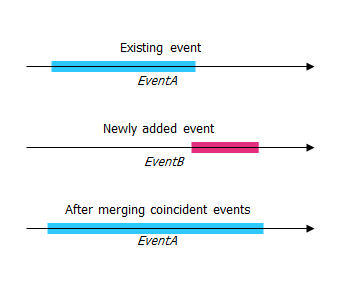
- Interdire les mesures hors de l’itinéraire : les valeurs en entrée pour les mesures de départ et d’arrivée sont comprises dans la plage des valeurs de mesure minimale et maximale sur l’itinéraire sélectionné.
- Supprimer les superpositions : le système ajuste la mesure et les dates de début et de fin des événements existants de sorte que le nouvel événement n’entraîne pas de superposition des valeurs temporelles ou des mesures.
- Cliquez sur Next (Suivant).
L’onglet présentant le jeu d’attributs des événements s’affiche.
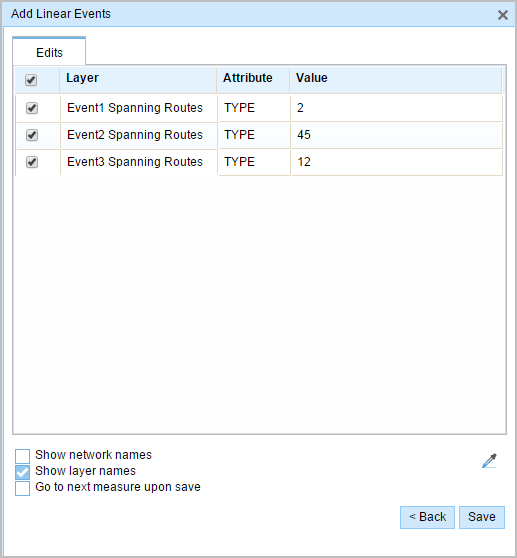
Remarque :
Les cases à cocher vous permettent d’ajouter des données pour des événements spécifiques dans le jeu d’attributs. Aucun événement n’est ajouté pour les événements qui ne sont pas cochés.
- Spécifiez les informations attributaires pour le nouvel événement de l’une des manières suivantes :
- Fournissez les informations attributaires pour le nouvel événement dans les tables définies par les jeux d’attributs.
- Cliquez sur Copier les valeurs attributaires
 et sur un itinéraire sur la carte pour copier les attributs d’événement d’un autre itinéraire.
et sur un itinéraire sur la carte pour copier les attributs d’événement d’un autre itinéraire.
Event Editor utilise un jeu d’attributs par défaut sous l’onglet Mise à jour. Vous pouvez modifier le jeu d’attributs pour créer des jeux d’attributs personnalisés ou utiliser le jeu d’attributs configuré par l’administrateur.
Remarque :
Les valeurs précodées, les domaines par plage et les sous-types sont pris en charge lorsqu’ils sont configurés pour un champ dans la table Valeur attributaire.
- Use the following options to access more information on the attribute set:
- Cochez la case Afficher le nom du réseau pour afficher le réseau LRS associé à la couche d’événements sélectionnée.
- La liste des attributs figurant dans les tables définies par les jeux d’attributs peut provenir de plusieurs couches d’événements. Pour identifier la couche d’événements source de chaque attribut, sélectionnez la case à cocher Afficher les noms des couches.
- Checking the Go to the next measure upon save check box results in prepopulating the From measure value using the To measure value of the present section to continue the event creation process.
- Cliquez sur Enregistrer.
Les nouveaux événements linéaires sont créés et apparaissent sur la carte. Un message de confirmation s’affiche en bas à droite lorsque les nouveaux événements linéaires qui viennent d’être ajoutés ont été enregistrés.
Une fois qu’un événement linéaire a été créé, vous pouvez procéder comme suit pour continuer à caractériser l’itinéraire :
- Cliquez sur Nouvelle mise à jour pour effacer toutes les entrées saisies dans le widget et rétablir les valeurs par défaut de la géodatabase dans la table.
- Cliquez sur Mise à jour suivante pour conserver aisément toutes les entrées existantes dans le widget et le jeu d’attributs à des fins pratiques et mettre à jour rapidement des caractéristiques similaires.
Vous avez un commentaire à formuler concernant cette rubrique ?